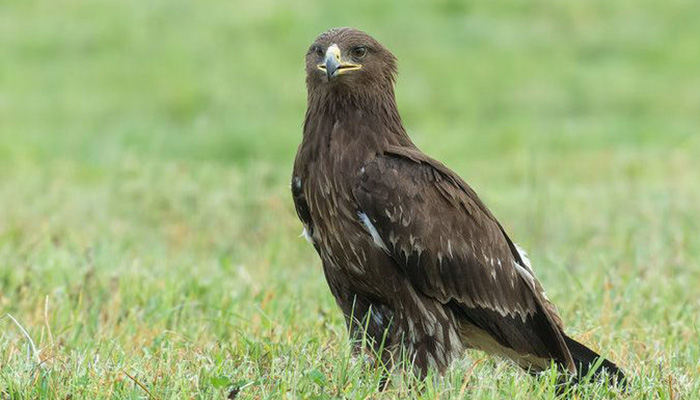
English: Greater
Spotted Eagle, Spotted Eagle
Russian: Большой подорлик
German: Schelladler
French: Aigle
criard
Mongolian: Бор бүргэд
Japanese:
カラフトワシ (Karafuto-washi)
Status: Very rare species. According to the
IUCN Red listcategories and criteria, the species evaluated as-Endangered.
Distribution and Range: Breeds and summers in Russian Federation, from the Fareast to the
Syrdaria River valley, migrates through eastern part of the Western Europe,
Russian Altai and China, winters in southern parts Asia and Europe, and Egypt.
In Mongolia: breeds in forests in forest steppe and taiga zones of the Khentii
mountains and Selenge River. It migrates through the above mentioned breeding
sites, the Great Lakes Valley, Khalkh River basin. Also in migration the species were sighted in
the surrounding areas of the Tarbagtai Mountain in the Khangai range, Great
Mountains of Zavkhan, on the south side Terkhiin River basin, in the north Ider
River, Ogii Lake in Arkhangai Aimag, Jargalant, Khorgo, Bayan-Ovoo in Bulgan
Aimag, areas laying between the Khutag-Ondor and Airkhan Lakes in Bulgan Aimag,
Khentii Mountain range, Bayangolynn valley in Mandal Soum, Kharaa River in
Zunnkharaa, near Terelj, near Altar in Tov Aimag.
Habitat: Breeding pairs build nests in tall trees in deciduous, coniferous
and mixed forests in river valleys in the forest steppe and taiga zones. In
migration passing the species can be seen individually in forest steppe, rivers
and lakes valleys, in areas with high rocky outcrops and cliffs.
Population and threats: In Mongolia, very rare breeding visitor (rarely, breeds) and
passage migrant. Threats: mining explorations, excavation, tree logging
commercial and household use, tourism related activities greatly degrade
nesting sites; forest and steppe fires; die from capture in traps intended for
saker falcons. In migration might die from poisoning from ingesting numerous
Gerbils (who ingested pesticides intended for Brandt’s Vole) and Brandt’s Voles
(for whom the pesticides were originally intended); also might crash into high
voltage wires, get electrocuted by high voltage currents; high intensify noises
also disrupt breeding birds.
Conservation Measures: Included as very rare animal in the Mongolian Law on Fauna,
Asian Red Data Book for Birds (2001); included in the CITES Annex II and the
CMS Annexes I and II. The species range in Mongolia is partially included
within the NSPAN.
Further Actions: Develop conservation plan based on further research of the
species population abundance, biology and ecology; determine conservation
management plans with local residentsparticipation in order to avoid causing
disruptions to breeding sites, improve on public awareness programs.